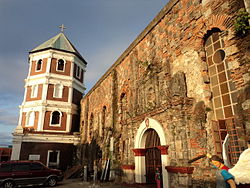| Atimonan Church | |
|---|---|
| Our Lady of the Angels Parish Church | |
 Church facade in 2010 | |
Location in Luzon | |
| 14°0′4.68″N121°55′17.22″E / 14.0013000°N 121.9214500°E | |
| Location | Atimonan, Quezon |
| Country | Philippines |
| Denomination | Roman Catholic |
| History | |
| Status | Parish church |
| Dedication | Mary |
| Architecture | |
| Functional status | Active |
| Heritage designation | National Historical Landmark |
| Designated | 1939 |
| Architectural type | Church building |
| Completed | 1700 |
| Administration | |
| Diocese | Lucena |
Our Lady of the Angels Parish Church, commonly known as Atimonan Church, is a Roman Catholic church located in Atimonan, Quezon, Philippines. It is under the jurisdiction of the Diocese of Lucena.
Contents
The first church was destroyed by the Dutch invaders in 1640. [1] The present church was completed in 1700, but was seriously damaged by an earthquake in 1937. [2] The National Historical Commission of the Philippines declared the church a national historical landmark in 1939. [3]





